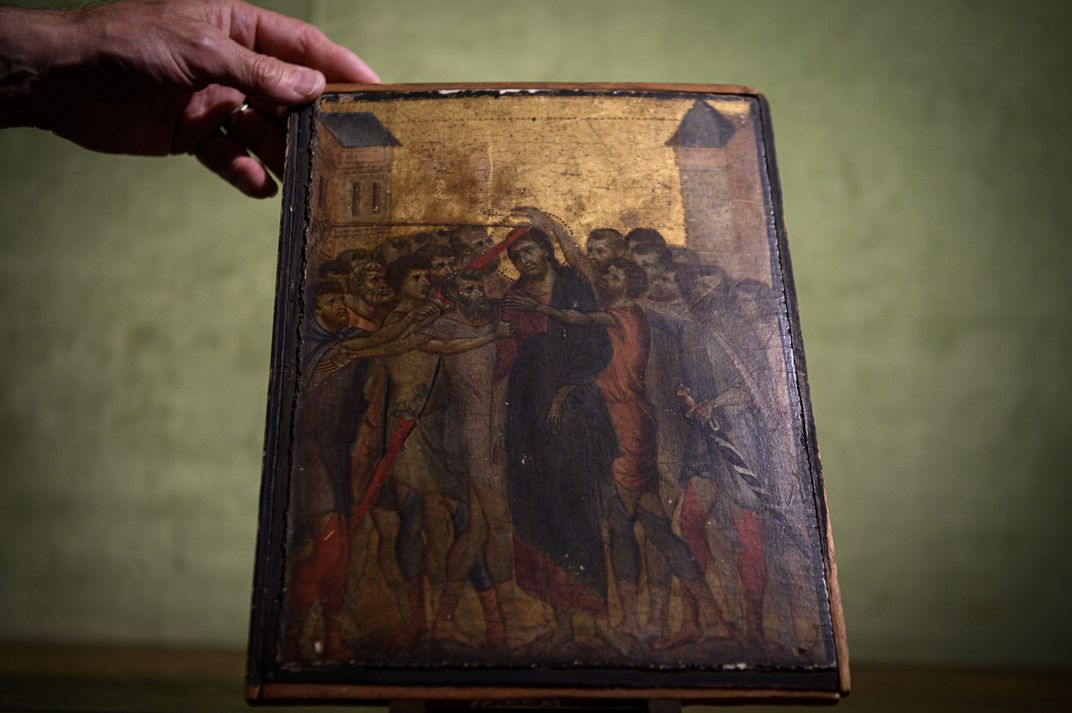Lost Renaissance Masterpiece Found Hanging Above Woman’s Hot Plate Sells for $26.8 Million
Experts say the panel painting was created by Florentine artist Cimabue around 1280
:focal(338x345:339x346)/https://tf-cmsv2-smithsonianmag-media.s3.amazonaws.com/filer/59/bb/59bbb90b-b694-4aee-bf3f-64d8d7563a95/http___cdncnncom_cnnnext_dam_assets_190924094952-02-cimabue-masterpiece-discovered-scli-intl.jpg)
Editor's Note, October 28, 2019: Cimabue's“Christ Mocked” sold at auction for $26.8 millionthis weekend.
A small panel painting discovered hanging above a hot plate in an elderly French woman’s kitchen is likely a long-forgotten work by Florentine artist and early Renaissance master Cimabue.
As Elie Julien reports for Le Parisien, auctioneer Philomène Wolf chanced upon the religious scene—expected to sell for upward of $6 million in an October 27 sale—while clearing out a nonagenarian client’s Compiègne home.
“I had a week to give an expert view on the house contents and empty it,” Wolf tells Julien. “I had to make room in my schedule. … if I didn’t, then everything was due to go to the dump.”
Wolf spotted the painting, titled “Christ Mocked,” on display between the woman’s open-plan kitchen and living room. While she immediately suspected it was a work of Italian primitivism, she “didn’t imagine it was a Cimabue.”
Wolf turned to Eric Turquin, a Paris-based art historian who had previously identified a painting unearthed in a French attic as a long-lost Caravaggio. According to Benjamin Dodman of France 24, Turquin and his colleagues concluded with “certitude” that the new find was a genuine Cimabue.

Based on their assessment, the researchers suggest the panel belongs to a polyptych created by the Old Master around 1280. Today, just two other sections of the work are known to survive: “The Flagellation of Christ,” purchased by New York’s Frick Collection in 1950, and “The Virgin and Child With Two Angels,” acquired by the National Gallery in London in 2000. (The latter of these panels was another chance discovery; per the Guardian’s Maev Kennedy, a Sotheby’s staffer came happened on the work while conducting a routine valuation of a Suffolk country estate in 2000.)
Speaking with the Art Newspaper’s Scott Reyburn, Turquin says a key piece of evidence supporting the attribution is a trail of centuries-old tracks left by wood-gnawing larvae. All three boast comparable worm hole patterns. “You can follow the tunnels made by the worms,” Turquin says. “It’s the same poplar panel.”
Indications of the painting’s provenance also include its style, gold background and frame fragments. Jerome Montcouquil, an art specialist at Cabinet Turquin, tells CNN’s Jack Guy and Saskya Vandoorne that the team was able to “follow the grain of the wood through the different scenes.” He adds, “We also used infrared light to be sure the painting was done by the same hand. You can even see the corrections [Cimabue] made.”
But art critic Jonathan Jones cautions jumping to any definitive conclusions just yet. “Christ Mocked” is “being boldly called a Cimabue without wider discussion,” he writes in the Guardian, emphasizing that identifying such old paintings “is and always has been fraught with peril.” It’s possible, for instance, that the work was actually made by a follower of Cimabue, or a painter from another region entirely.
Cimabue, born Cenni di Pepo around 1240, is perhaps best known as Giotto’s teacher. Although he is the first individual highlighted in Giorgio Vasari’s landmark biography of Italian artists, he has long been overshadowed by his better-known pupil. As Holly Flora, an art historian at Tulane University, says to France 24’s Dodman, Cimabue—an early proponent of Renaissance painting, which prized naturalism and perspective more than the preceding Byzantine style—should “be appreciated for his own inventiveness and not just as a prelude to Giotto.”
Per the Guardian’s Angelique Chrisafis, the French woman who owns the panel had always assumed it was a nondescript religious icon. The painting has been in her family for so long that she knows nothing of its origins, including how it happened to end up in her relatives’ possession.
Joanna Cannon, a historian at the Courtauld Institute of Art, tells the Telegraph’s Alastair Sooke suggests that the rediscovered trio may have formed the left wing of an altarpiece that was cut apart and sold during the late 18th or early 19th century. If this assessment proves accurate, Cannon says, there are “still five other panels to find.”
/https://tf-cmsv2-smithsonianmag-media.s3.amazonaws.com/accounts/headshot/mellon.png)
/https://tf-cmsv2-smithsonianmag-media.s3.amazonaws.com/accounts/headshot/mellon.png)